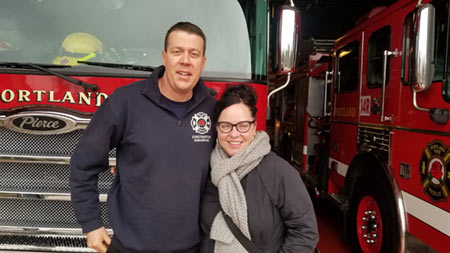By Theresa McSherry | Oregon Burn Center

Oregon’s wet, cold winters bring Concordians inside our homes craving the crackling warmth of our fireplaces and woodstoves.
Data from the U.S. Fire Administration show the threat of winter fires is real. I am a burn specialist who cares for survivors of burn injuries.
I am also a person who experienced the humbling reality of my own home catching fire. Thank you to Portland Fire & Rescue Station 14 in Concordia for saving my life and home.
Nationwide in 2017, one person died every three hours and 20 minutes in a house fire. Other fires caused a death every two hours. According to the National Fire Incident Reporting System, heating equipment is the culprit of one in four Oregon winter house fires and a leading cause of winter house fire deaths.
Another leading cause of house fires is cooking appliances. Evening – 5 to 8 p.m. – is the most common time for these fires. So how can we protect our homes and loved ones?
- Use nonflammable screens in front of the fireplace opening to prevent sparks from jumping out, unwanted material from going in, and help prevent the possibility of burns from touching the hot metal or glass. My office is full of new walkers who toddle over and land palm first on a hot metal or glass door. Establish “no” zones.
- Wood stoves need at least 36 inches of adequate clearance from flammable surfaces – plus kindling, paper and décor – and proper floor support and protection.
- Wood stoves should be good quality and should be lab tested for safety. It should be placed on an approved, noncombustible stove board or hearth to protect the floor from heat and hot coals.
- Chimneys should be inspected yearly, and cleaned if needed, especially if they have not been used for some time. • Never, ever, use flammable liquids to start or accelerate any fire. Ever.
- Never burn charcoal indoors. It can give off deadly amounts of carbon monoxide.
- Place space heaters at least three feet away from anything that can burn: furniture, blankets, curtains, paper products, etc.
- Choose space heaters that turn off automatically if they tip over. Buy and use only space heaters that have the label of a recognized testing laboratory.
- Install smoke and carbon monoxide alarms on every floor – even the basement – ideally outside every sleeping area. Replace them every 10 years. Most victims of fires die from smoke inhalation, not from burns.
- Make and practice a fire escape plan.
Theresa McSherry FNP-C is a burn specialist, board certifed family nurse practitioner. She pract ices at The Oregon Clinic Surgical Burn Specialists, Legacy Emanuel Oregon Burn Center and the Legacy Wound and Burn Clinic. Theresa has lived in Concordia for 25 years and has loved watching it grow into the vibrant community it has become.